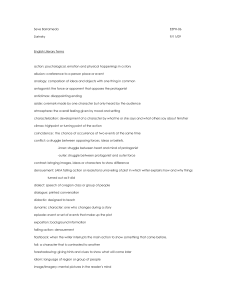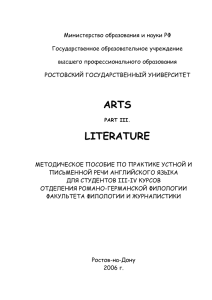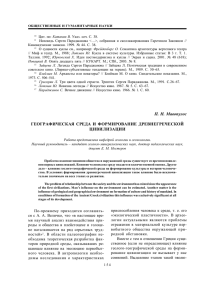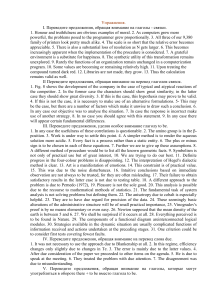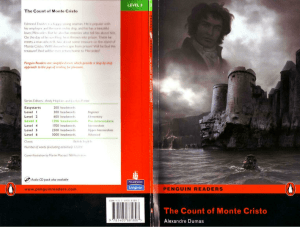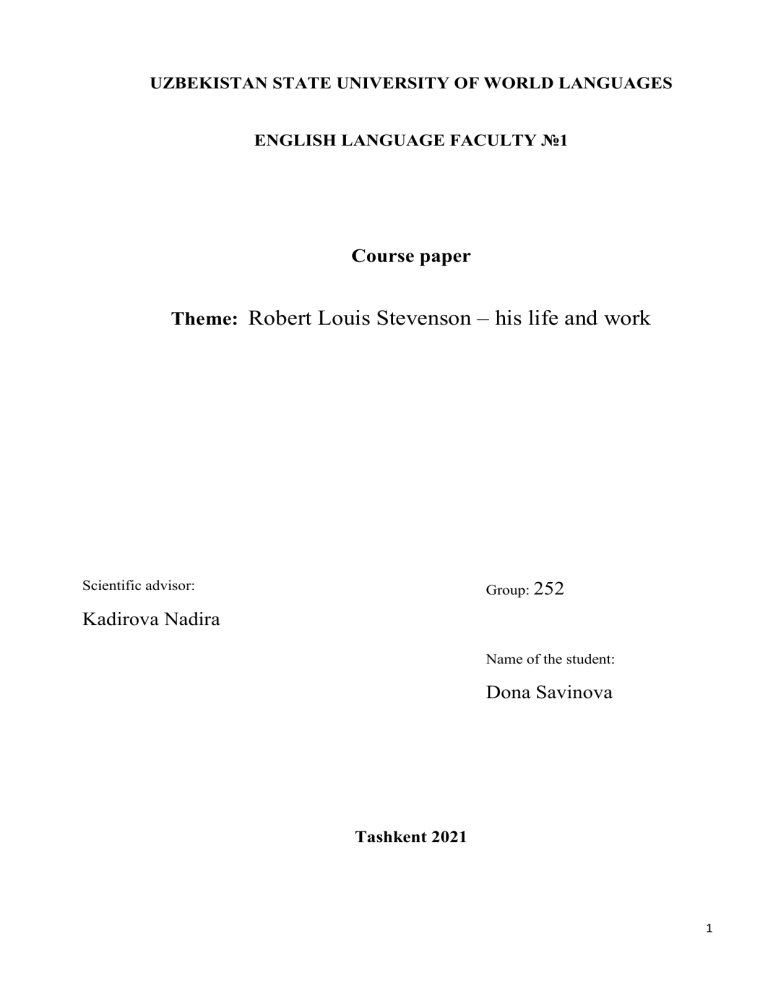
UZBEKISTAN STATE UNIVERSITY OF WORLD LANGUAGES ENGLISH LANGUAGE FACULTY №1 Course paper Theme: Robert Louis Stevenson – his life and work Scientific advisor: Group: 252 Kadirova Nadira Name of the student: Dona Savinova Tashkent 2021 1 Илмий раҳбар томонидан берилган ТАҚРИЗ Исми, шарифи ________________________________________________________________ ________________________________________________________ фанидан ёзган курс иши _____________________________________________________________________________ _____________________________________________________________________________ _____________________________________________________________________________ _____________________________________________________________________________ _____________________________________________________________________________ _____________________________________________________________________________ _____________________________________________________________________________ _____________________________________________________________________________ Мазкур курс иши якунланган деб ҳисоблайман ва уни ҳимояга тавсия этаман. Тақризчи _________________________ (исми, шарифи) ____________ (имзо) “____”____________ 2020 йил 2 “Тасдиқлайман” __________Кафедра мудири “____”_________2020 йил КУРС (иши) ЛОЙИҲАСИ Гуруҳ ______ талаба ____________________________ Раҳбар_________________________ ТОПШИРИҚ 1. Ишлайдиган лойиҳа (мавзу) _______________________________________________ _______________________________________________________________________ _______________________________________________________________________ 2. Бошланғич маълумотлар__________________________________________________ _______________________________________________________________________ _______________________________________________________________________ _______________________________________________________________________ 3. Қўлланмалар __________________________________________________ _______________________________________________________________________ _______________________________________________________________________ _______________________________________________________________________ 4. Чизма қисмининг тузилиши ______________________________________________ _______________________________________________________________________ _______________________________________________________________________ _______________________________________________________________________ 5. Ёзма қисмининг тузилиши ________________________________________________ _______________________________________________________________________ _______________________________________________________________________ _______________________________________________________________________ 6. Қўшимча вазифа ва кўрсатмалар ___________________________________________ 7. Курс (иши) лойиҳасини бажариш режаси 1 2 3 4 Ҳимоя 3 ROBERT LOUIS STEVENSON – HIS LIFE AND WORK CONTENTS: Pages INTRODUCTION 2 MAIN PART 1. Beginning of the journey with childhood illness 2 2. Youth and the start of a writing career 2 3. Personal life 2 4. Stevenson's Treasure Island is an unsurpassed masterpiece 2 5. Writing Successes 4 6. Glimpses of neo-romanticism in his work 1 7. Deteriorating health and a move to Samoa 2 8. End of the Path 2 CONCLUSION 1 REFERENCES 1 4 INTRODUCTION Robert Louis Stevenson (1850-1894) — poet, novelist, literary critic, publicist, one of the founders and prominent representatives of the neo-romantic movement. The author of numerous novels and novels of adventure genre, the most famous among which was "Treasure Island". Robert was born into the family of a Scottish engineer. After receiving a law degree, he became addicted to travel. He traveled in Europe and America, lived in the Pacific Islands, and died there, far from his homeland. He took an active part in the struggle of the Samoans against the German colonialists, showing a keen interest in national history and the works of a number of writers, creating a gallery of literary portraits of F. Marriet, A. Dumas, J. Verne and others. Exoticism and romance had for him the power of attraction, which was caused not so much by a thirst for the unusual as by an escape from a world of pure wealth and falsehood. Robert Louis Stevenson owes his enduring popularity to poetry as well as to adventure novels, the plots of which he built on detective plots, on the dangers of travel, on fantastic assumptions. The example of the adventure genre was his novel "Treasure Island" (1883), which picked up and developed the tradition going from "Robinson Crusoe," D. Defoe, but giving it a different direction. Jim Hawkins, the young son of the innkeeper, is drawn into a dangerous voyage by a mystery connected to the appearance of an old sailor in the inn, singing a sinister sea song. The news that this sea wolf is afraid of the coming of a certain one-legged man, and the events that follow his arrival, fascinate Jim so much that he leaves his parents' home and goes in search of the treasure hidden by the famous pirate Flint on a distant island lost in the middle of the ocean. However not sea storms, but the unbridled greed of the easy money seekers - that is what the young hero has to tackle first in order to preserve his spiritual purity and grow morally mature, to unravel and frustrate the intrigues of the villains. 5 The aim of my course paper is to explore the biography and works of Robert Lewis Stevenson. To reach the aim I put forward the following tasks: to study the whole chronology of events from Stevenson R.L.’s life to investigate Stevenson R.L contribution to English Literature to analyze how neo-romanticism relates to his work to consider the main motives of the writer concerning the creation of works of the chosen genre The subject of my course paper is Robert Louis Stevenson – his life and work. The object of my course paper is Stevenson R.L.’s biography and writing career. The course paper includes introduction, 8 chapters, conclusion and list of references. The main part includes a story of his early childhood, his first steps toward his calling of destiny. Then there is note of the period of his youth, which coincided with his first beginnings as an independent writer. Then comes an equally important part - about his wife and family, who played a special role in his life. Beginning with this, the narrative moves smoothly to the disclosure of the writer's work - his successes, the messages in his works, the characteristics and the connection with the direction of neo-romanticism. The work ends with a description of his last years of life, which passed as dignified as the rest of his lifetime as well. 6 MAIN PART 1. Beginning of the journey with childhood illness Stevenson was born in Edinburgh, Scotland, into the family of a lighthouse engineer. His father was Thomas Stevenson, a hereditary engineer and lighthouse specialist. At the age of 18 he gave up his mother's maiden name, Balfour. The boy had been told since childhood that as an adult he would have to open his own business and produce even better models of lighthouses, but Robert had always had a neutral attitude toward the profession. It was hard to say what it was that displeased him. The fact that his parents, being constantly busy, gave him little attention, or the work itself with its hours-long search for the right part, which, if mismatched, doubled and tripled the process. But despite all this, the boy watched his parents' work with quite a lot of interest and even tried to help them. At age 5, Robert suffers his first serious illness - croup. It is a severe inflammation of the upper respiratory tract, due to which the patient begins to breathe rapidly and unevenly and coughing hoarsely. Croup is considered the most dangerous disease for children, because their immune system is the most difficult to cope with the virus, which in some cases is fatal. In time, however, Stevenson managed to completely overcome the disease, but, according to some biographers, ligament problems accompanied him throughout his life. Constantly confined to the walls of the house, the boy could not develop as other children. But he could travel as much as he liked, though only in his imagination. Dreams carried him so far that parents wondered how in the head of their son could be born such fantasies. The development of creative abilities and contributed to the nurse Robert, she knew a lot of interesting stories, read from memory works of Robert Burns, and every night before going to bed told him a different story. Thanks to Nanny, Stevenson developed a sense of the word and literary taste. 7 It was to her he will dedicate the first book of poems addressed to children in the history of literature. This book begins with the words: "Holding the wealth of the whole earth, we must be happy as kings. It was written in a new way. The author did not teach readers to behave and obey their mother, but portrayed a child's world as beautiful and mysterious. As soon as Robert turned 7, he went to school. From that moment on, his interests and attitude toward life changed dramatically. He quickly makes new friends at the school, and they are almost never separated: they go to classes together, have lunch together in the school cafeteria, and go for walks. At the same time, Robert develops a passion for adventure. His parents, having decided that all boys his age dream of travel and danger, do not pay attention to it, but Robert Lewis now knows for sure that there should always be adventures in his life. 2. Youth and the start of a writing career Robert's creative biography began at the age of fifteen with an essay entitled "The Pentland Rebellion. A Page of History, 1666." But after writing it, the young man faced a serious problem: he had no money to publish it. And since he had not yet worked anywhere, getting the manuscript out into the world was simply impossible. His father comes to his rescue and publishes the book on his own dime. From that very moment, the people of Edinburgh learn about the new writer. Around the same age Robert went on a trip to Scotland and other European countries. He wrote down his impressions and interesting incidents he witnessed on the trips. Later, based on these notes appeared essays included in the books An Inland Voyage, 1878 and Virginibus Puerisque (1881). Growing up, Stevenson became a student at Edinburgh Academy and then went on to study at Edinburgh University. At first, the boy decided to continue his father's cause, and enrolled in the engineering department, where for several months he 8 learned how to make lighthouses. But, after a while, the young man realizes that he never wants to produce anything else, or even to be a participant in the process. In 1871, Robert participated in a competition announced by the Scottish Academy and was awarded a silver medal for his scientific work “A New Kind of Flashing Light for Lighthouses». However, despite threats and quarrels with his parents over disagreements about Robert's path, he left the faculty and entered the law department, which he graduated with honors in 1875. Just as Stevenson had dreamed, his life was always full of adventure, even in spite of an illness that was making itself felt. He kayaked on mountain rivers, climbed mountains and traveled to many cities, which was later reflected in his second work, «The Road». By the way, this title was not chosen by Robert by chance. It was meant to symbolize all the courage and bravery of a man who is in the stage of development of a serious illness, but absolutely does not pay attention to it. At the end of his journey, Stevenson hurries to his native Edinburgh to quickly express on paper all his emotions and publish several manuscripts. Thus, his works such as An Inland Voyage (1878), Travels with a Donkey in the Cevennes (1879), are published. (1879), The Suicide Club (1878), and The Rajah’ Diamond (1878). A year later, Robert publishes a whole series of works, united by the title "The New Arabian Nights”. 3. Personal life The first time Robert fell seriously in love with a girl named Kat Drummond, a singer from one of Edinburgh's night taverns. Their romance lasted for several months, after which the future writer tried to propose to the girl. But his father was able to put out the ardor of a young man in love, he simply did not give permission 9 for this marriage, arguing that the singer from the cabaret is not too suitable party for the role of the spouse and his son deserves better. Later, while traveling in France, the writer met Frances Mathilde Osborne in 1876, a married lady of 36, the mother of two children: a sixteen-year-old daughter, Isabelle Osborne, who would later record her stepfather's works under his dictation, and a nine-year-old son, Lloyd Osborne, Stevenson's first listener and future collaborator. Frances had a passion for painting, revolving around artists. Robert was ten years younger than her, and this seemed an insurmountable obstacle to the development of their relationship. He suggested that Fanny get a divorce and marry him. Three and a half years passed between their first meeting and their marriage. Fanny was an American, a strong-willed, intelligent, and "practical" woman. Through her efforts, Stevenson's final reconciliation with her father finally took place. At first the parents, to prevent this marriage, deprived their son of material support. But they underestimated the strength of his feelings and forgot the "flintiness" of his character. For the sake of Fenny Stevenson crossed the ocean in the ship's hold, overcame a two-week journey in an American train without a sleeping car. Sick and exhausted, he appeared before Fanny unexpectedly, putting the woman in a very difficult position. He endured hardship and poverty, an exacerbation of tuberculosis, and yet in May 1880 the tormented lovers were married. They returned to England in first class (all expenses were borne by his father). Fanny immediately realized that she entered a respectable bourgeois family with more than mediocre means: the father assigned them a modest, but enough to get by, and in the spring of 1885 the family settled in a house, a gift to Fanny Thomas Stevenson. His son named his new home in gratitude to his father, Skerryvor. 10 All these years Stevenson worked tirelessly and very hard, one after another came out his books. Even bedridden after another throat bleed - half-blind, with his hand tied, he did not leave his literary work. Despite the fact that Stevenson's health was in critical condition, his works remained vivid, full of optimism and were a great success with readers. 4. Stevenson's Treasure Island is an unsurpassed masterpiece As the writer recalled, he once played with his stepson, Lloyd Osborne. They were competing to see who could draw a geographical map better. It was then that Stevenson created a map of Treasure Island. On the second day, he sat down for a novel he called «The Ship's Cook», but the publisher didn't like the title and they decided to change the title to Treasure Island. The inquisitive reader will notice details of many famous adventure books in this work. Stevenson did not deny this. He said frankly that, for example, the parrot for the novel "flew in" from «Robinson Crusoe», and he borrowed the skeleton from a short story by the famous American writer Edgar Poe, «The Golden Beetle». By the way, the story behind the novel "Treasure Island" is not so much a writer's fiction. In those days, as today, many people raved about the countless treasures of pirates or their victims, which were prudently hidden in different places around the world and which could be found behind certain secret signs. For example, on the island where Alexander Selkirk lived for more than four years and which was later called Robinson Crusoe's Island, they are still searching for the huge treasure that was hidden there a few years after Selkirk was released. It is as if Stevenson had collected in his book all the features and findings of adventure literature, which is hard to imagine without secret maps, hidden treasure, and warlike pirates. The first listeners and critics of the yet-to-be-printed novel were the writer's father and stepson. Stevenson recalled that when it was necessary to fill Billy Bones' chest, the writer's father spent almost an entire day on the back of an envelope from some 11 business letter making a list of what should be in the former pirate's stash. This list is almost entirely included in the novel. In general, Stevenson managed to fill his work with details that in the reader's imagination after this particular novel were closely associated with the world of adventure and mystery: a rousing pirate song, a terrible black mark, a mysterious map and an island lost in the ocean, full of gold washed in blood. 5. Writing Successes Fearing for his reputation as a serious writer, Stevenson first published the novel «Treasure Island» in a magazine for teenagers and under a pseudonym. The unexpected success dispelled doubts, and a separate edition in 1883 bore the writer's real name. The novel brought the author worldwide fame and immediately became a classic of the adventure genre. Despite the fact that even today such words as "pirates", "treasure", "desert island" may strike the imagination of a young reader, the secret of the success of the novel still lies not only in the exciting plot. From the very first lines of the novel we discover a friend in the form of a boy named Jim. He has been asked to tell "the whole story, from beginning to end, without concealing any details," and he keeps his promise honestly, offering an almost documentary-like account. Stevenson inherited this tone of simple coherent narrative from Daniel Defoe, author of Robinson Crusoe. The boy's lively and ingenuous story makes the reader look at events through Jim's eyes, sympathize with him, and follow his adventures with unrelenting attention. Stevenson masterfully conveys the bewilderment of a teenager who finds himself in a complex adult world where good and evil are so intricately intermingled that it takes hard work of the mind and heart to learn to distinguish one from the other. Jim does not make himself out to be a hero, although more than once he manages to save the situation. Acting on impulse, he often finds no explanation for his 12 actions and is either ashamed or proud of their unexpected consequences: it is not good that he left the camp, but he took the ship. The actions of adults are no less contradictory, and it is even harder for Jim to make sense of them. Amazement is the feeling that accompanies his narrative. Billy Bone, the drunkard and cutthroat who brought misfortune to Jim's house, elicits sympathy when he finds himself the powerless victim of the pirates' revenge. Squire Trelawney acts like a child, carelessly entrusting his ship to a gang of outlaws. And the boy's main enigma is Long John Silver. It is to his charms that Trelawney, Dr. Smollet, and Jim himself succumb. The villain is not simple at all; he is notable for his uncommon wit. Sometimes the boy openly admires his dexterity and courage, and Silver himself treats Jim with warmth, especially when they have to confront angry bandits together. The psychological richness of the characters enhances the poignancy of the story. Stevenson keeps the reader's attention, each time beginning a new episode not at the beginning but at the end of a chapter. The novel contains no tedious descriptions of nature, no abstract philosophical arguments and, most importantly, no edification, but this only helps to understand what moral lesson the boy has learned from his ordeal. To appreciate the author's skill, let us compare the first and last paragraphs of the book. Jim explains, "It is not yet possible to specify where this island lies, for even now there are treasures stored there which we have not taken out." The reader is intrigued, but the epilogue deceives expectations. There will be no new journey. The gold has lost its appeal: "We each got our share of the treasure. Some have disposed of the wealth cleverly, and others, on the contrary, foolishly, according to their temperament." When talking about the others, Jim did not say a word about himself. The attentive reader should have noticed that throughout the novel, Jim does not seek to get hold of the treasure, nor does he make any plans to enrich himself. He is still true to himself: "The rest of the treasure - the silver in bullion 13 and the guns - still lies where the late Flint buried it. And I think I'll let it lie there. There's nothing to lure me to that damned island now. I still dream at night of storms crashing on its shores, and I jump out of bed when I hear the hoarse voice of Captain Flint (that was the local parrot's name): - Piasters! Piasters! Piasters! Two other adventure novels, Kidnapped (1886) and Catriona (1893), were written in the same manner and also on behalf of a boy. The first takes place against the backdrop of real historical events of the 18th century. The main character, David Balfour, suffers a lot of hardships because his uncle, a ruthless scoundrel, wants to take away his nephew's rightful possession. David is kidnapped and sent to America; on the way, under unusual circumstances, he finds a loyal friend. The ship on which they are sailing is wrecked, but, after overcoming many dangers, the friends are saved, and David eventually succeeds in getting his rights restored. The novel Catriona tells how David Balfour, risking his own life and freedom, tries to save an innocent condemned man from death, as well as the hero's love for Catriona, the granddaughter of Rob Roy, Scotland's national hero. A special place in Stevenson's oeuvre is occupied by the fantastic tale The Strange Case of Dr. Jekyll and Mr. Hyde (1886). Dr. Jekyll, a well-meaning gentleman, suffers from the intolerable contradictions of his character. Through laboratory experiments, he creates a double who embodies his bad qualities. The double begins to live his life, commits repulsive acts and does not stop even before murder. Subsequently, the names of Jekyll and Hyde became common nouns, they symbolize the inextricable connection of contradictory traits in human nature. Stevenson's historical novels - Prince Otto (1885), Black Arrow (1888), published posthumously St. Eve (1897), where the adventure is made even more entertaining by the whimsical interweaving of the exotic past with real facts and real personalities. 14 6. Glimpses of neo-romanticism in his work Stevenson's work belongs to neo-romanticism, an artistic movement that emerged at the turn of the 19th and 20th centuries. The high ideals of the past have not lost their appeal, but a sober outlook and subtle irony indicate the acquired maturity. The character of Norsemore, the protagonist of The House on the Dunes (1880), is so sharply opposed to demonism and nobility that it might have become a parody, were it not for the quiet and detailed tone of the narrator, reminiscent of the intonations of the originators of the 18th century English novel. Prince Florizel is a character in two series of stories from the collection The New Arabian Nights (1882): The Suicide Club and Rajah’s Diamond. On the face of it, it is the perfect romantic hero. An amateur detective, he unselfishly fights criminals, protecting innocent victims and beautiful ladies. Florizel rid society of Diamond Raja as the source of evil and crime, but he cannot cope with the inexorable course of history: the prince loses his throne and his fatherland and engages in "keeping a cigar shop on Rupert Street, often frequented by other political émigrés as well." Thanks to Stevenson, the short story has become a highly respected genre, though previously it had not been taken seriously by critics. 7. Deteriorating health and a move to Samoa The subsequent death of his father allowed the writer to change his life. He first moved to America with his family, hired a Casco yacht and sailed the South Seas for seven months. The sea wanderings brought Stevenson back to life; he was again filled with strength, able to communicate with people, row, ride, and cut his way through the thicket. Life seemed like a magical fairy tale to him. Terrifying storms and squalls raged in the South Seas, and sailing between islands was very 15 dangerous... But experience had shown that only living near the equator made Stevenson feel good. The success of Treasure Island provided material wealth for Stevenson's family, but a progressive illness required a change of climate, and so he left his beloved Scotland. Robert Stevenson's biography was filled with new events and adventures. The writer traveled with his family to the southern seas. He settled on the islands of Samoa in the Pacific Ocean. The locals were at first wary of the stranger, for they were used to Europeans appearing in their lands only to get rich. But Stevenson showed no disdain for the local population, but he welcomed them into his home, which the locals felt like a huge palace, and listened to their stories of antiquity with pleasure. Very soon the locals came to Stevenson's house not only to hear his master's amazing and incredible stories, but also to ask for help. He advised them on how to defend themselves against colonizers, how best to care for their land, and where best to sell certain goods. The white colonizers disliked the writer, but the locals, as a sign of special respect and trust, gave him the name Tuzitala, "white master storyteller," because they believed in the magical power of his words. And that power was great, one need only recalls the publicity Stevenson's article about the shameless plundering of the islands by the leading European countries that colonized Samoa had caused in Europe. Thus Stevenson's relationship with the natives soon developed into one of friendship, and he often hosted them in his wooden, two-story house in the village of Vailima. The locals tramped a path to the writer's house, and called it the "Trail of Loving Hearts." Subsequently, the local authorities organized their residence in this house. 8. End of the Path Stevenson loved the island of Samoa, he liked everything there - the nature, the climate, the locals. Unfortunately, this island was also the place of his death. Robert Stevenson died on December 3, 1894. The night before, he was about to 16 join his family for dinner, when suddenly he abruptly wrapped his arms around his head, as if he wanted thus to cure the unbearable pain. It seemed as if the writer was suddenly struck by a blow of unimaginable force. A few hours later, Robert was gone, he died of a stroke. Stevenson was given an honorable burial - his grave is located on top of Mount Vea, where the waters of the Pacific Ocean stretch out on either side as far as the eye can see. To pay final tribute to Tuzitala, a group of 60 Samoans slowly made their way up the steep slopes of the mountain, in total silence, using axes and hoes to make their way to the spot the writer himself had chosen for his grave. On Stevenson's tomb, according to his will, is inscribed the poet's poem "Requiem»: Under the wide and starry sky Here may the winds about me blow; Dig the grave and let me lie. Here the clouds may come and go; Glad did I live and gladly die, Here shall be rest for evermore, And I laid me down with a will. And the heart for aye shall be still. This be the verse you grave for me; "Here he lies where he longed to be, Home is the sailor, home from sea, And the hunter home from the hill." 17 CONCLUSION After Stevenson's death 30 volumes of his works were published. The writer's talent is bright and multifaceted, he worked in a variety of genres - novels, short stories, travel essays, novellas, poems, essays, plays. Tracing the main stages of the formation of Stevenson’s "romanticism", first of all we should remember the first two books Stevenson: An Inland Voyage, 1878 and Travels with a Donkey in the Cevennes, 1879). In these works, Stevenson showed himself to be a skilled essayist and a brilliant stylist. On the basis of amusing misunderstandings, travel adventures, chance encounters, and not too interesting events he created stories full of charm, in which one feels the freshness of perception, the "living soul" of the author. REFERENCES 1. Menikoff, Barry (1987), “Class and Culture in the English Short Story”, Journal of the Short Story in English 8 (1987), pp. 125-39. 2. Woolf, Leonard, “The Fall of Stevenson”, Essays on Literature, History, Politics etc.. (London: Hogarth Press, 1927) 3. Robert Louis Stevenson: the Critical Heritage, ed by Paul Maixner (London: Routledge & Kegan Paul, 1981) 4. G.K. Chesterton, Robert Louis Stevenson (London: Hodder & Stoughton, 1927) 5. “New Arabian Nights: Stevenson’s experiment in Fiction”, NineteenthCentury Literature 43 (iii 1990), pp. 339-62. 6. Noble, Andrew, From the Clyde to California. Robert Louis Stevenson’s Emigrant Journey (Aberdeen: Aberdeen University Press, 1985) 18

